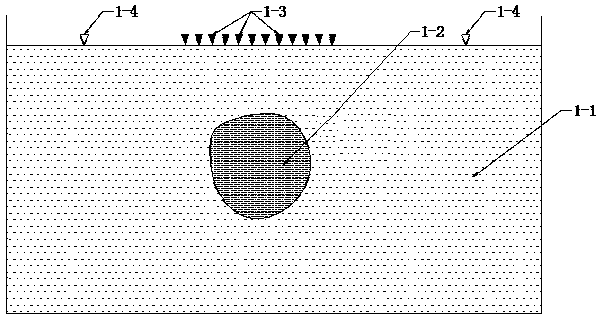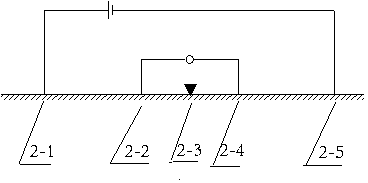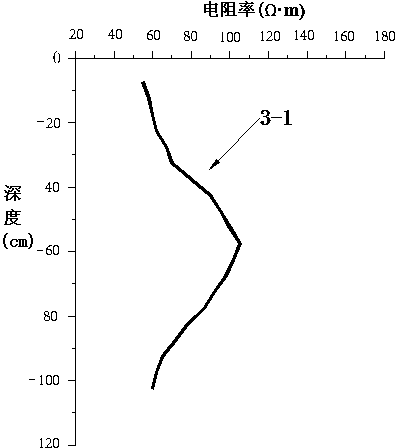Method for positioning artificial wetland clogging area through resistivity curve
A technology of artificial wetlands and resistivity, which is applied in the directions of electric/magnetic exploration, utilization of re-radiation, re-radiation of sound waves, etc.
- Summary
- Abstract
- Description
- Claims
- Application Information
AI Technical Summary
Problems solved by technology
Method used
Image
Examples
Embodiment 1
[0028] (1) if figure 1 , 2 As shown, firstly, the resistivity sounding point 1-3 is arranged above the suspected blockage area 1-2, and the DC resistivity symmetrical quadrupole sounding device is used for measurement. The distance between the measuring electrode M2-2 and the measuring electrode N2-3 is 10 cm, and the power supply The positive electrode A2-1 of the electrode and the negative electrode B2-5 of the power supply electrode are from 0.2m to 2m with a difference of 10cm, press figure 2 The DC resistivity symmetric quadrupole sounding device shown conducts resistivity sounding of the point from shallow to deep.
[0029] (2) The positive electrode A2-1 of the power supply electrode, the negative electrode B2-5 of the power supply electrode, the measurement electrode M2-2, and the measurement electrode N2-3 of the DC resistivity symmetrical quadrupole sounding device are all arranged symmetrically on both sides of the measuring point O2-3, Every time the electrode s...
Embodiment 2
[0035] In this embodiment, the comparative resistivity curve is used to locate the clogged area of the constructed wetland.
[0036] (1) if figure 1 , 2 As shown, firstly, the resistivity sounding point 1-4 is arranged above the area 1-1 determined to be unblocked in the constructed wetland, and the DC resistivity symmetrical quadrupole sounding device is used for measurement, the measuring electrode M2-2 and the measuring electrode N2-3 The distance is 10cm, the positive pole of the power supply electrode A2-1 and the negative pole of the power supply electrode B2-5 are from 0.2m to 2m with a difference of 10cm, press figure 2 The DC resistivity symmetric quadrupole sounding device shown conducts resistivity sounding of the point from shallow to deep.
[0037] (2) The positive electrode A2-1 of the power supply electrode, the negative electrode B2-5 of the power supply electrode, the measurement electrode M2-2, and the measurement electrode N2-3 of the DC resistivity sym...
Embodiment 3
[0044] In this embodiment, it is assumed that we do not know the clogged area of the constructed wetland at all, that is, the approximate location of the suspected clogged area of the constructed wetland cannot be determined, and the blocked area of the constructed wetland is located using the resistivity bathymetry curve type map.
[0045] (1) if figure 1 As shown, if you do not know the approximate location of 1-2, first arrange the resistivity sounding points evenly above the artificial wetland at a distance of about 50cm, and use the DC resistivity symmetrical quadrupole sounding device to measure, and the measuring electrode M2-2 The distance between the measuring electrode N2-3 and the measuring electrode N2-3 is 10cm, and the positive pole of the power supply electrode A2-1 and the negative pole of the power supply electrode B2-5 are from 0.2m to 2m with a difference of 10cm, press figure 2 The DC resistivity symmetric quadrupole sounding setup shown takes resist...
PUM
| Property | Measurement | Unit |
|---|---|---|
| electrical resistivity | aaaaa | aaaaa |
| electrical resistivity | aaaaa | aaaaa |
Abstract
Description
Claims
Application Information
 Login to View More
Login to View More - R&D
- Intellectual Property
- Life Sciences
- Materials
- Tech Scout
- Unparalleled Data Quality
- Higher Quality Content
- 60% Fewer Hallucinations
Browse by: Latest US Patents, China's latest patents, Technical Efficacy Thesaurus, Application Domain, Technology Topic, Popular Technical Reports.
© 2025 PatSnap. All rights reserved.Legal|Privacy policy|Modern Slavery Act Transparency Statement|Sitemap|About US| Contact US: help@patsnap.com



